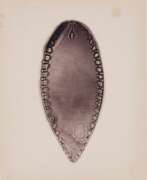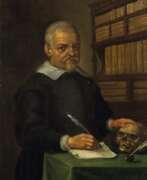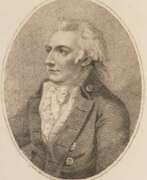Surgeons


Désiré-Magloire Bourneville was a French physician, neurologist, innovator and educator, and statesman.
Born into a modest family, Bourneville began his medical education in 1860 and for about ten years worked as an assistant to Jean-Martin Charcot, where, together with Paul Régnard, he supervised the publication of "Photographic Iconography of Salpetriere". During the Franco-Prussian War, he served as both surgeon and physician's assistant. Appointed physician at Bissetre, Borneville devoted himself to the medical and educational care of "idiots and epileptics" for whom he organized a service, and later directed the Fondation Vallée in Gentilly until his death. He is considered one of the earliest child psychiatrists.
In 1876, Bourneville was elected a municipal councilor of Paris, three years later he became a general councilor of the Seine, and then a deputy. In this capacity, Bourneville carried out several health reforms: he became the rapporteur for the public assistance budget and the budget for psychiatric asylums, achieved the creation of the first special classes for mentally retarded children, and the first municipal nursing school in Salpêtrière.
Bourneville had many very different talents. Very early on he became interested in medical journalism, where he made a name for himself through the vividness of his articles. In 1873, he founded the journal Progrès Médical, which promoted the tenets of avant-garde medicine, open to pioneering scientific developments (Bourneville published Charcot's lessons) and social issues. He fully developed the theoretical and practical foundations of teaching for the nursing profession. Outraged by the lack of practitioners' professional knowledge of obstetrics, he worked to create a new medical specialty, gynecology. But his main purpose in life was to educate and nurture those who were labeled "idiots" and mentally retarded.


Girolamo Fabrici d'Acquapendente, also known as Girolamo Fabrizio or Hieronymus Fabricius, was an Italian anatomist and surgeon and the founder of embryology. The Latinised form of his name, under which his works can be found, is Hieronymus Fabricius (ab Aquapendente).


Wilhelm Fabry von Hilden or Fabricius von Hilden (Latin: Fabricius Hildanus) was a German and Swiss Renaissance physician and surgeon, the founder of scientific surgery.
In 1576 he began a four-year apprenticeship as a surgeon with a barber in Neuss. Surgery at that time was considered the craft of bath and barbers; surgeons or wound doctors treated wounds, broken bones, inflammations, and many other ailments. After completing his apprenticeship, Fabry worked for five years as an assistant wound surgeon to Cosmas Slot (died 1585) at the court of Duke Wilhelm V in Düsseldorf. To expand his anatomical knowledge, Fabry constantly dissected and prepared cadavers. In later years, he also encouraged his students to do so and conducted public autopsies to draw attention to the importance of anatomical knowledge. He also made it a habit to do practice procedures on a cadaver before surgery.
In 1615 Fabry was appointed city physician of Bern. Here he wrote several books on gunshot wounds. In 1623 the versatile physician published a small book, "Christian and Good-Hearted Caution against Drunkenness," which he republished in more detail the following year under the title Christlicher Schlafftrunck. Fabry's most important surgical treatise was Observationem et curationem chirurgicam centuriae sex ("Six hundred surgical observations and cures"), first published in 1606. This compilation remained the most important book of German surgery until Lorenz Heister. It describes new surgical methods and surgical instruments for the treatment of amputations, nasal polyps, bladder stones, dropsy, hernias, ascites, etc., etc., etc.
For centuries, Fabricius remained one of the most respected surgeons not only in Germany and Switzerland, but throughout Europe. Among his many accomplishments in the field of surgery may be enumerated his innovation in the amputation of the thigh, for which he invented a special tourniquet; the excision of involved axillary glands in breast cancer; the first classification of burns into three degrees with the appropriate treatment for each variety; and the first description of a medical field chest for military purposes.
Although in his later years Fabritius had already given up practicing medicine, he continued to write medical papers and maintain an active scientific correspondence until his death. He authored some 20 medical books. It was his surgical works, translated into German, French, Latin, English and Dutch, that ensured his recognition centuries later.


Gabriele Falloppio was an Italian physician and anatomist of the Renaissance.
Originally a priest, Falloppio soon left for Ferrara to study medicine and was later appointed anatomy professor there, and in 1548 he became head of the anatomy department at Pisa. Three years later he accepted the offer of the Venetian Senate to become professor of anatomy, surgery, and botany at Padua, where he remained for the rest of his life. It was in this city that he made his most famous discoveries, was director of the famous botanical garden, and wrote two medical textbooks.
He also gained a reputation as an excellent teacher and lecturer, attracting many Italian and foreign students to the medical faculty of the University of Padua. As a physician, he made a thorough study of the clinical aspects and treatment of syphilis, and proposed the condom as a defense against venereal disease.
Falloppio was a versatile scientist and an able physician and surgeon, describing, among other things, the semicircular canals, the cuneiform sinuses, the trigeminal, auditory and lingual pharyngeal nerves, the canal of the facial nerve, and the fallopian tubes, named Fallopian tubes in his honor. Falloppio described his discoveries in his three-volume work Opera genuina omnia, published in Frankfurt in 1600 and in Venice in 1606.


Jacques Guillemeau was a French pioneering surgeon, obstetrician and ophthalmologist.
Born into a family of prominent Orleans physicians, he received a classical education and moved to Montpellier at the age of 21 to study medicine. With the support of his father, a respected surgeon at the court of the French king, Jacques Guillemeau studied under the country's leading physicians. In 1569 Guimault moved to Paris, and in 1574 he succeeded his teacher and royal surgeon Ambroise Paré (1510-1590). Guillemeau assisted Dr. Paré during the war in France and Flanders (1576-1580), and from 1581 he performed surgical operations at the Hotel Dieu hospital in Paris.
During his long career, Dr. Guillemeau earned a reputation as a skilled and experienced surgeon, also publishing several works that gave him a prominent place in the medical community of his time. In 1584, Guillemeau published his "Treatise on Eye Diseases", and in 1585, his "Treatise on the Ailments of the Soul". In 1609, his groundbreaking book "Happy Childbirth in Women" was published. And his "Works on Surgery", written for young surgeons, were regularly reprinted until the middle of the 17th century.


John Thomas Redmayne was a British surgeon, physician and amateur naturalist.
Redmayne trained as a physician and surgeon in Glasgow, then received his diploma at Guy's Hospital in London and was licensed by the Royal College of Physicians in Edinburgh.
In addition to being a physician, J. Redmayne was an amateur naturalist, he became interested in microscopy and specialized in diatom algae. He is considered one of the most successful microphotographers of the time, and his founding of the Bolton Microscopical Society allowed him to concentrate on the study of diatoms. His microscopic diatom plates were highly respected, particularly for the relative purity of the species. He also mounted histological preparations. Redmayne gave copies of his book to the Quekett Microscopical Club (which he joined in 1876) and the Royal Microscopical Society.


Marco Aurelio Severino was an Italian surgeon, anatomist and zoologist, one of the founders of comparative anatomy.
From childhood Severino studied Latin, Greek, rhetoric, poetry and law in various schools in Calabria, then continued his studies in Naples, soon moving from law to medicine. In Naples he met Tommaso Campanella, who had a great influence on the formation of his worldview. After receiving a medical degree in Salerno in 1606, he studied surgery in Naples with Giulio Jasolino. In 1615 Severino was appointed the first surgeon at Ospedale degli Incurabili. Severino made significant contributions to the transformation of naturophilosophy, medical and surgical practice, to which much of his printed work is devoted.
Severino's main contribution, however, lies in his anatomical works, especially the Zootomia Democritea. This work may be called the earliest comprehensive treatise on comparative anatomy. Severino is considered one of the pioneers of comparative anatomy.
Severino's cultural interests extended far beyond medicine. He corresponded with many prominent physicians and scientists of his time, including William Harvey and John Houghton in England, Thomas Bartolin and Ole Worm in Denmark, J.G. Volkamer and Johannes Wesling in Germany, and Campanella, Jasolino, and Tommaso Cornelio in Italy. Severino was tried by the Inquisition for allegedly unorthodox religious and philosophical views, but was eventually acquitted. He died of the plague in Naples.


Adriaan van den Spiegel (or Spieghel), name sometimes written as Adrianus Spigelius, was a Flemish anatomist born in Brussels. For much of his career he practiced medicine in Padua, and is considered one of the great physicians associated with the city. At Padua he studied anatomy under Girolamo Fabrici.
His best written work on anatomy is De humani corporis fabrica libri X tabulis aere icisis exornati, published posthumously in 1627. In his 1624 treatise De semitertiana libri quatuor, he gave the first comprehensive description of malaria.


Andreas Vesalius (Dutch: Andries van Wesel) was a Flemish physician, one of the first anatomists of the Renaissance.
Vesalius came from a family of physicians and apothecaries, studied at the Catholic University of Leuven and at the medical school of the University of Paris, where he learned to dissect animals. He also had the opportunity to dissect human cadavers and devoted much time to the study of human bones. He later went to the University of Padua and, after earning his MD degree, was appointed professor of surgery, whose duties included anatomical demonstrations.
Vesalius revolutionized the study of biology and medical practice through his careful description of the anatomy of the human body. Based on observations made by himself, he wrote and illustrated the first complete textbook of anatomy. In 1543 his major work De humani corporis fabrica libri septem ("Seven Books on the Structure of the Human Body"), commonly known as Fabrica, was printed. In this epochal work, Vesalius gave far more extensive and accurate descriptions of the human body than anything that had been done by his predecessors.
In the same year, 1543, the Holy Roman Emperor Charles V appointed him staff physician of his house, and in 1559 Vesalius became physician to the Madrid court of Charles V's son, Philip II.
Vesalius' work made anatomy a scientific discipline with far-reaching implications not only for physiology but for all of biology.















